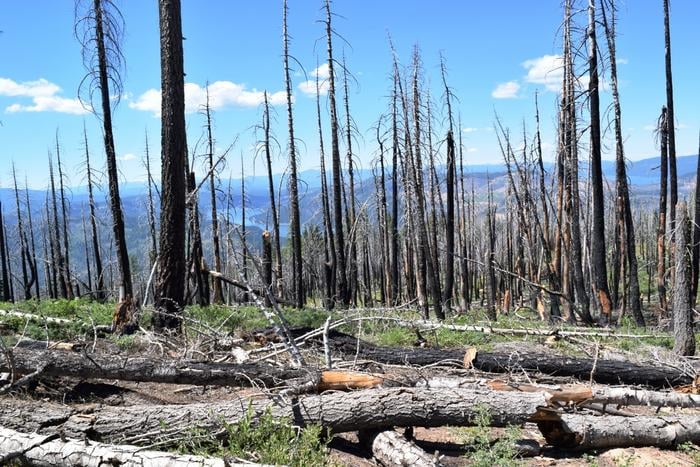Researchers discover that removing woody debris instead of burning it reduces wildfire risks and boosts carbon storage
Dead branches and fallen logs scattered across the forest floor might look natural, but in today’s warming world, they’re increasingly becoming tinder for catastrophic wildfires. Now, researchers have found that the simple act of collecting and removing this wood—rather than setting it ablaze in controlled burns—could transform how we manage forests while tackling climate change.
In the Sierra Nevada mountains of California, where devastating wildfires have become almost annual events, a team from Florida Atlantic University investigated whether physically harvesting dead wood could reduce wildfire severity while simultaneously improving carbon storage. Their findings, published this month in the Journal of Environmental Management, suggest this approach offers surprising benefits that prescribed burns alone can’t match.
“In our increasingly warming world with frequent dangerous fire weather, more people and structures at risk in the wildland-urban interface, health risks from exposure to smoke, and need to enhance carbon sequestration to mitigate global warming, scientists need to examine effective alternative management actions,” said Scott H. Markwith, a professor in the Department of Geosciences at FAU’s Charles E. Schmidt College of Science and co-author of the study.
A Century of Unintended Consequences
The story of western forests is one of good intentions gone awry. For nearly a century, forest managers suppressed virtually all fires, inadvertently allowing dangerous levels of fuel to accumulate on forest floors. Combined with climate change and severe drought, this policy has led to increasingly destructive megafires that deviate dramatically from historical fire patterns.
Today’s standard approach to reducing wildfire risk includes prescribed burning—intentionally setting controlled fires to clear out accumulated brush and debris. But these burns emit substantial carbon and produce smoke that creates significant public health concerns.
“Over time, repeated fuel reduction treatments, such as prescribed burns, can emit more carbon than a single wildfire in an untreated forest,” explained Rabindra Parajuli, lead author and a postdoctoral researcher at the University of Georgia who conducted the research while earning his doctorate at FAU. “However, by harvesting dead wood and converting it into biochar—a stable form of carbon—emissions can be reduced. This process not only mitigates health impacts but also increases carbon sequestration, helping to offset the effects of climate change while promoting healthier forest ecosystems.”
Learning from Indigenous Practices
The researchers drew inspiration from Indigenous Peoples’ forest management practices, which included not just controlled burning but also the collection of dead wood for firewood and other uses. In fact, historical estimates suggest that Indigenous Peoples in the Sierra Nevada region may have collected enough dead fuel annually to cover 168% of the forested area.
Using computer simulations with data collected from 43 forest plots in California’s Plumas and Lassen National Forests, the team tested eight different forest management approaches. These ranged from no intervention to various combinations of thinning (removing smaller trees), prescribed burning, and physical harvesting of dead wood.
Double Benefits: Less Fire, More Carbon Storage
The results were striking. When researchers simulated extreme wildfire conditions—the kind that fuel catastrophic blazes—they found that combining thinning with physical harvesting (labeled “ThPy” in the study) performed remarkably well.
This combination reduced the probability of tree crowning (when fire jumps from the ground to the forest canopy) by more than 70% compared to untreated forests. It also resulted in the lowest tree mortality, with less than 10 square meters of basal area per hectare killed, compared to more than 25 square meters in untreated forests.
Perhaps most surprisingly, this approach reduced carbon emissions from wildfires by 28% compared to the more common practice of thinning plus prescribed burning. When researchers factored in the potential for converting harvested wood into biochar and other long-lasting wood products, the combined thinning and harvesting approach was the only treatment that produced more carbon sequestration than emissions.
“By combining physical harvesting with thinning—removing smaller or fire-vulnerable trees—evidence from this research suggests we can help restore healthy, resilient forests,” Markwith noted. “This approach, paired with transforming wood into carbon-storing products rather than burning it, could reduce wildfire severity and smoke and carbon emissions, while also generating carbon credits.”
Practical Challenges Remain
While the findings are promising, implementing widespread physical harvesting would require overcoming significant logistical challenges. The study didn’t evaluate cost-effectiveness, though the researchers noted that mechanical thinning followed by forest residue collection and conversion to innovative products has proven economically feasible in other studies.
The approach could be particularly valuable in areas where prescribed burning is risky or restricted, such as near homes in the wildland-urban interface, valuable recreational areas, or critical wildlife habitats.
As climate change continues to create increasingly extreme fire weather conditions and narrow the windows for safe prescribed burning, alternatives like physical harvesting may become essential tools in the forest management toolkit.
The study represents a potential shift in thinking about forest residue—from waste to be burned to valuable resource that can help mitigate climate change while making forests more resilient. Further research will need to evaluate how this approach performs over multiple treatment cycles and across different forest types.
For western forests caught in a dangerous cycle of fuel accumulation and increasingly severe wildfires, this old-yet-new approach offers a glimpse of hope—a way to work with nature rather than against it, much as Indigenous Peoples did for thousands of years before modern fire suppression policies changed the landscape.
If our reporting has informed or inspired you, please consider making a donation. Every contribution, no matter the size, empowers us to continue delivering accurate, engaging, and trustworthy science and medical news. Independent journalism requires time, effort, and resources—your support ensures we can keep uncovering the stories that matter most to you.
Join us in making knowledge accessible and impactful. Thank you for standing with us!

